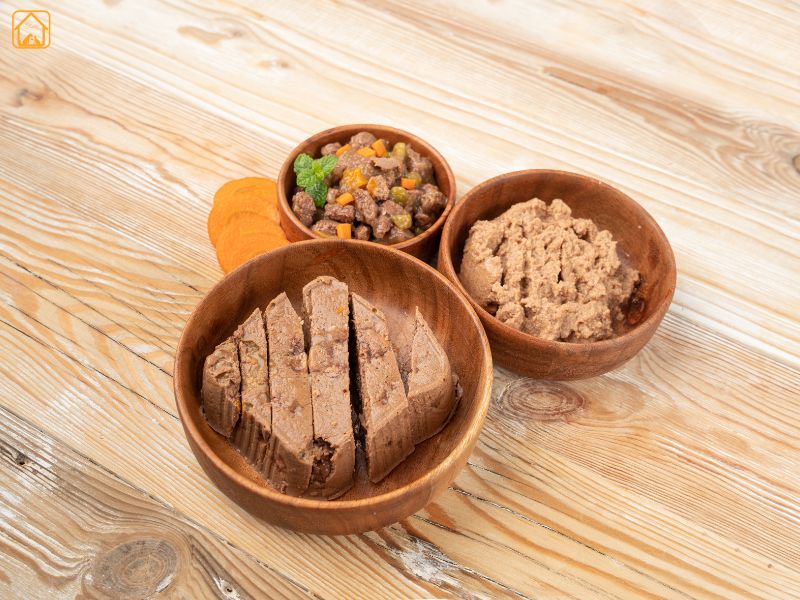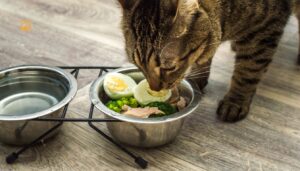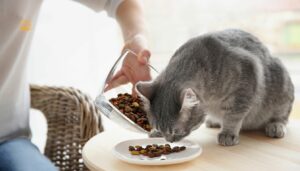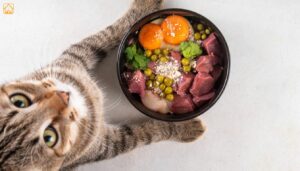Key Differences Between Wet and Dry Cat Food
The most obvious difference in the wet cat food vs dry cat food conversation is water content. Wet cat food contains about 70-80% moisture, making it soft and easy to eat. Dry cat food, on the other hand, has only about 10% moisture and comes as hard kibble.
- Wet food feels and smells more like meat, which most cats find irresistible. It’s usually packaged in cans or pouches and needs refrigeration after opening.
- Dry food is crunchy, less aromatic, and shelf-stable. You can leave it out longer without worrying about spoilage.
Storage and convenience matter too. Dry food is easy to store, buy in bulk, and scoop out whenever. Wet food takes up more space and requires refrigeration once opened.
Nutritional Composition and Hydration
What’s Really Inside? And Why Water Matters
When it comes to wet food vs dry cat food, nutrition labels matter. Wet food usually has higher protein and fewer carbohydrates, closer to what cats would eat in the wild. Dry food, though, packs more calories per bite and often includes more carbs and fiber.
- Hydration: Cats naturally don’t drink a lot of water. Wet food helps, supporting kidney and urinary health. Dry food requires that your cat drinks more water separately.
- Calories: Dry food is more calorie-dense, so it’s easy to overfeed if you’re not careful. Wet food lets cats eat a larger volume with fewer calories, supporting weight management.
- Protein & Carbs: Wet food typically offers more animal protein, while dry food tends to have more grains or plant-based ingredients.
Some cats, especially seniors or those with medical needs, benefit from the extra moisture in wet food. I’ve seen friends switch their older cat to mostly wet, and the difference in energy and comfort was noticeable within weeks.
Benefits of Wet Cat Food
Hydration, Palatability, and More
If you’re wondering, is wet cat food good for cats? For many, the answer is yes, especially for cats prone to urinary issues or dehydration. Here’s why pet parents and vets often recommend it:
- Hydration: High moisture supports kidney and urinary tract health.
- Texture and Taste: Most cats love the smell and feel, great for picky eaters or those with dental issues.
- Lower Calories: Helps with portion control and weight management.
- Digestibility: Easier on sensitive stomachs; often recommended for seniors or recovering cats.
I remember my own cat refusing to eat after a minor illness, wet food, warmed just a little, was the only thing she would touch. It truly can be a lifesaver.
Disadvantages of Wet Cat Food
Cost and Convenience Drawbacks
Of course, nothing is perfect. Let’s look at the disadvantages of wet cat food so you can make a balanced decision:
- Cost: Wet food is generally more expensive than dry.
- Spoilage Risk: Leftovers spoil quickly, within hours if left out, especially in warm weather.
- Storage: Needs refrigeration after opening, and takes up more space.
- Dental Health: Wet food doesn’t help clean teeth, so regular dental care is a must.
Cleaning up leftover wet food isn’t fun, especially if your cat is a grazer rather than a meal finisher.
Benefits of Dry Cat Food
Convenience, Cost, and Practicality
So, is dry cat food or wet cat food better? For some families, dry food is the go-to for good reasons:
- Convenience: Easy to store, serve, and buy in bulk. Fits busy schedules.
- Shelf Life: Can be left out for hours even all day, perfect for free-feeding or using in puzzle feeders.
- Cost-Effective: Less expensive per meal, making it budget-friendly.
- Potential Dental Benefit: Some dry foods help reduce tartar, though brushing is still best for dental health.
And for multi-cat households trust me, dry food can make feeding time less chaotic.
Disadvantages of Dry Cat Food
Hydration and Health Concerns
But dry food isn’t perfect either. Here are a few downsides in the dry v wet cat food discussion:
- Low Moisture: Can increase risk of dehydration and urinary issues, especially in cats who don’t drink much.
- Overeating Risk: Calorie-dense, so portion control is important to prevent weight gain.
- Texture Preference: Some cats dislike the crunch or have trouble chewing, especially seniors or those with dental pain.
- Carb Content: Many dry foods have more carbohydrates, which don’t suit every cat’s needs.
Ever tried switching a stubborn cat from wet to dry? Sometimes, no amount of coaxing works, they know what they want.
Mixing Wet and Dry Cat Food
Mixing wet and dry cat food can be a great way to offer a balanced, flexible diet that keeps your cat both happy and healthy. Many cat parents and vets recommend this approach because it combines the benefits of both food types.
Here’s why mixing might work well for your cat:
- Hydration boost: Wet food helps keep your cat hydrated, especially if they don’t drink much water.
- Texture variety: Mixing gives your cat different textures to enjoy, which helps with picky eaters.
- Portion control: You can adjust the mix to control your cat’s weight and calorie intake.
- Convenience: Dry food is easy to store and lasts longer, while wet food feels like a tasty treat.
- Flexible feeding: Offer wet food in the morning and dry food at night, or mix both in one bowl.
Just remember to monitor your cat’s weight and energy levels, and adjust portions as needed.
How to Choose: Factors Based on Age, Health, Lifestyle, and Budget
There’s no one-size-fits-all answer to wet cat food vs dry cat food. Here’s how to decide what’s best for your cat:
- Age: Kittens need more protein and calories; seniors may need softer textures.
- Health: Cats with kidney, urinary, or dental issues often benefit from wet food. Overweight cats may do better with carefully portioned wet or a mix.
- Lifestyle: Busy households might need the convenience of dry food.
- Budget: Dry food is cheaper, but wet food may provide health benefits that save costs later.
- Preference: Some cats just have a favorite, and sometimes you have to meet them halfway.
Need tailored advice? Most vets love talking about cat nutrition, don’t hesitate to ask at your next visit.
FAQs: Wet vs Dry Cat Food
Is it OK if my cat only eats dry food?
Yes, as long as it’s a complete, balanced cat dry food and your cat drinks plenty of water. But, keep an eye out for urinary issues and encourage frequent water breaks. You can also try adding a splash of water or broth to the kibble for extra hydration.
Is wet cat food good for cats’ teeth?
Wet cat food doesn’t clean teeth like some dry foods might, but neither replaces brushing. Dental treats, regular vet checks, and tooth brushing are best for oral health.
How often should I feed my cat wet food?
This depends on your cat’s needs and schedule. Some cats do well on wet food once daily, others twice or mixed with dry. Check with your vet for a plan that fits your cat’s age, weight, and health.
What wet cat food is best for cats?
Look for brands with high-quality animal protein, minimal fillers, and an AAFCO nutritional statement. Your vet can recommend options suited for your cat’s life stage or health condition.
Is it OK to give cats wet food every day?
Absolutely! Daily wet food can support hydration and is especially helpful for cats at risk of urinary or kidney issues. Just be mindful of portion sizes to avoid overfeeding.
Can I mix wet and dry cat food?
Yes, mixing wet and dry cat food offers both hydration and convenience. Use a measuring cup or scale, and consult your vet or a mixing calculator to get the ratio right.
Does cat age affect wet vs dry food choice?
Definitely. Kittens often need higher protein and calories, usually found in wet food. Seniors may prefer soft textures or need extra hydration, making wet food a good pick. Always match food to your cat’s life stage.
Conclusion
In the end, the “right” cat food isn’t just about labels; it’s about love, balance, and paying attention to your cat’s unique needs. Whether you choose wet, dry, or both, the best choice is one that keeps your cat healthy, happy, and always running to the bowl with joy.



